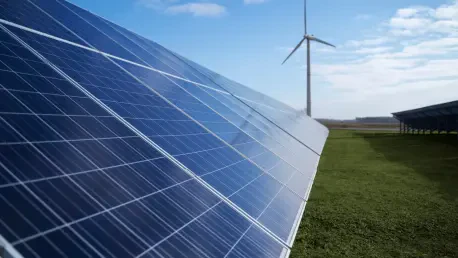In today’s exploration of India’s dynamic energy landscape, we engage with Christopher Hailstone, a renowned expert in energy management with a keen focus on renewable energy and electricity delivery. With India witnessing the fastest decline in coal-fired power generation in five years and achieving a milestone in renewable energy output, Christopher offers an insightful perspective on these significant shifts, touching upon the factors driving these changes and future implications for the country’s energy policy.
Can you explain the factors that have contributed to the fastest decline in coal-fired electricity in India in the past five years?
The decline in coal-fired electricity generation in India is largely influenced by multiple factors like the increased adoption of renewable energy sources and a strategic shift towards less polluting alternatives such as hydro and nuclear power. Additionally, there has been a marked decrease in power demand primarily due to milder temperatures and suppressed economic activity, which collectively contributed to this significant drop.
How has the overall power demand in India changed recently, and what are the main reasons for this decrease?
Overall power demand in India has shown a downward trend recently, attributed to cooler temperatures this year, reducing the dependency on air conditioning, alongside economic headwinds affecting manufacturing and industrial activity. The slow recovery from the pandemic also plays a part, leading to subdued power consumption.
Renewable energy generation in India reached a record high in May. What specific renewable sources contributed to this increase?
India has seen a remarkable surge in renewable energy output, particularly from solar and wind energy. These sources have benefitted from government incentives, improvements in technology, and increased investment, allowing them to integrate more effectively into the power grid and set new records for energy generation.
How have hydro and nuclear energy impacted the decline in coal and natural gas-fired power generation?
Both hydro and nuclear energy have played crucial roles in reducing dependency on fossil fuels by providing cleaner, consistent power. Hydropower, in particular, registered significant growth due to favorable water availability, while nuclear energy continues to be a stable component of the energy mix, further lessening the load on coal and natural gas facilities.
Could you elaborate on the economic headwinds that have affected both the power sector and non-power industries in India?
The economic landscape has been challenging due to factors like inflation, reduced consumer spending, and slower industrial output growth. These elements directly impact the power sector by suppressing demand, while non-power industries face pressure from fluctuating raw material costs and a sluggish global economy, which in turn dampens energy consumption.
How have Asian spot LNG prices changed this year, and what impact have these changes had on India’s energy market?
Asian spot LNG prices have seen a noticeable decline of over 15% this year, influenced by lower demand from major buyers like China and India. This price drop contributes to a reduction in LNG import volumes as domestic energy production is prioritized, impacting the operating economics of gas-based power generation in India.
With India’s coal-fired power generation dropping, how is the country planning to adjust its energy mix moving forward?
India is proactively working towards a diversified energy mix by increasing investments in renewable energy infrastructure and focusing on expanding capacity for solar and wind power. The government is also evaluating energy storage solutions and grid enhancements to ensure a robust transition from coal dependency to sustainable power sources.
How do record coal stocks and slower growth in power demand influence India’s import decisions regarding coal and LNG?
The combination of high coal stock levels and a tempered growth in power consumption has prompted India to cut down on coal and LNG imports. This strategy aligns with the country’s aim to minimize import bills and enhance energy security by relying more on domestically available resources and renewable initiatives.
What role did high temperatures play in India’s energy demand last year, and how does that compare to the current year?
Last year, soaring temperatures drove energy demand significantly higher as air conditioning and cooling needs peaked. This year, however, milder temperatures have helped mitigate demand spikes, allowing the country to manage its energy consumption more effectively without resorting to higher fossil fuel usage.
How have gas-based power plants been affected by the high gas prices and reduced power demand this year?
Gas-based power plants are facing challenges due to the combination of high gas prices and lower demand, which renders them less competitive compared to cheaper renewable alternatives. As a result, these plants are operating under capacity, impacting their financial viability and return on investment.
Can you provide more insight into the significant drop in natural gas-fired power generation recently experienced in India?
The considerable drop in natural gas-fired power generation is mainly a consequence of economic factors. With elevated natural gas prices and improved efficiencies in renewable technologies, there is a reduced incentive to operate these plants at full capacity, leading to the steep decline observed.
With renewable energy output increasing, can you discuss the strategies India is adopting to increase its share in the overall power mix?
India is implementing a multifaceted approach to boost the share of renewables in its power mix, which includes policy incentives, favorable tariffs, and massive investments in solar parks and wind farms. The country is also working on upgrading grid infrastructure to accommodate intermittent renewable energy sources more effectively.
How have milder temperatures affected peak electricity demand in India recently?
Milder temperatures have led to a softer demand impact on the power sector, particularly during peak hours. The reduced need for air conditioning has eased the pressure on both grid infrastructure and supply management, proving beneficial for transitioning towards a more renewable-centric energy system.
How does the current share of coal in India’s power mix compare to previous years?
The current share of coal in India’s power mix has decreased, notedly falling to 70.7% this May, marking a significant reduction from 74% a year prior. This trend reflects a deliberate move towards more sustainable forms of energy and diversification within the energy sector.
What are the expected trends for fossil fuel demand in India’s power generation in the coming years?
In the coming years, demand for fossil fuels is likely to continue its decline as renewable energy adoption accelerates and efficiency in energy storage technologies increments. However, coal will remain a crucial transitionary fuel due to its existing infrastructure and economic contributions.
Can you discuss how India’s energy transition can contribute to reducing its greenhouse gas emissions?
India’s transition towards greener energy sources is vital in reducing greenhouse gas emissions, as it seeks to cut down reliance on coal and minimize carbon output. By ramping up renewable capacities and modernizing its energy infrastructure, India is poised to make substantial contributions in its quest for sustainable growth.
What has been the impact on India’s energy policy from benchmarking prices of thermal coal and LNG reaching lows?
The drop in benchmark prices for thermal coal and LNG has encouraged a reevaluation of India’s import policies and pricing structures. This environment pushes for greater reliance on indigenous renewable sources while keeping coal as an auxiliary power buffer, thus informing long-term energy strategies.
Regarding hydropower’s growth, what schemes or projects have contributed to its increase in power generation?
Investments at both state and national levels underscore the growth in hydropower. Initiatives like the National Hydroelectric Power Corporation’s expansion projects and favorable policies for micro and mini hydropower plants have significantly contributed to the increased output.
What are the challenges and opportunities of India’s shift towards a more renewable-based energy infrastructure?
Transitioning to a renewable-focused infrastructure presents challenges like the need for technological advancements, financing, and regulatory adjustments. Yet, this shift also heralds opportunities including energy independence, economic growth through green jobs, and a substantial positive impact on the environment.
How do these energy trends and changes relate to India’s commitments and goals in fighting climate change?
India’s current energy trends align with its commitments to the Paris Agreement and other climate change initiatives by actively reducing its carbon footprint and increasing the use of cleaner energy sources. These efforts signify a steadfast resolve towards sustainable development and global climate commitments.
What is your forecast for India’s energy market in the next decade?
India’s energy future appears promising with a projected increase in renewable energy capacity, further reduction in coal dependency, and advancements in energy storage technologies. As policies continue to favor sustainable development, expectations are that India will emerge as a leader in renewable energy innovation globally.









